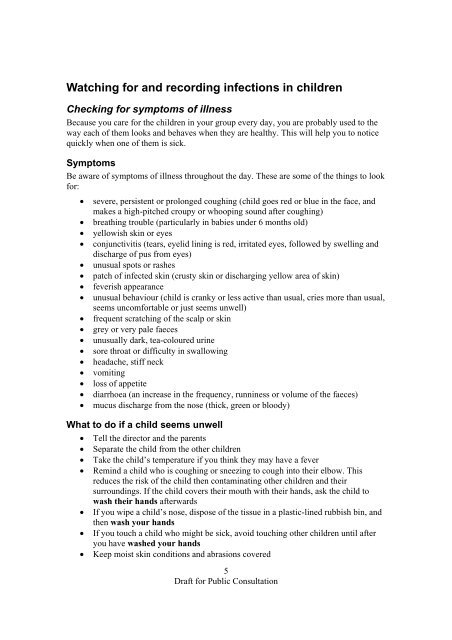Staying Healthy in Child Care - National Health and Medical ...
Staying Healthy in Child Care - National Health and Medical ...
Staying Healthy in Child Care - National Health and Medical ...
Create successful ePaper yourself
Turn your PDF publications into a flip-book with our unique Google optimized e-Paper software.
Watch<strong>in</strong>g for <strong>and</strong> record<strong>in</strong>g <strong>in</strong>fections <strong>in</strong> children<br />
Check<strong>in</strong>g for symptoms of illness<br />
Because you care for the children <strong>in</strong> your group every day, you are probably used to the<br />
way each of them looks <strong>and</strong> behaves when they are healthy. This will help you to notice<br />
quickly when one of them is sick.<br />
Symptoms<br />
Be aware of symptoms of illness throughout the day. These are some of the th<strong>in</strong>gs to look<br />
for:<br />
• severe, persistent or prolonged cough<strong>in</strong>g (child goes red or blue <strong>in</strong> the face, <strong>and</strong><br />
makes a high-pitched croupy or whoop<strong>in</strong>g sound after cough<strong>in</strong>g)<br />
• breath<strong>in</strong>g trouble (particularly <strong>in</strong> babies under 6 months old)<br />
• yellowish sk<strong>in</strong> or eyes<br />
• conjunctivitis (tears, eyelid l<strong>in</strong><strong>in</strong>g is red, irritated eyes, followed by swell<strong>in</strong>g <strong>and</strong><br />
discharge of pus from eyes)<br />
• unusual spots or rashes<br />
• patch of <strong>in</strong>fected sk<strong>in</strong> (crusty sk<strong>in</strong> or discharg<strong>in</strong>g yellow area of sk<strong>in</strong>)<br />
• feverish appearance<br />
• unusual behaviour (child is cranky or less active than usual, cries more than usual,<br />
seems uncomfortable or just seems unwell)<br />
• frequent scratch<strong>in</strong>g of the scalp or sk<strong>in</strong><br />
• grey or very pale faeces<br />
• unusually dark, tea-coloured ur<strong>in</strong>e<br />
• sore throat or difficulty <strong>in</strong> swallow<strong>in</strong>g<br />
• headache, stiff neck<br />
• vomit<strong>in</strong>g<br />
• loss of appetite<br />
• diarrhoea (an <strong>in</strong>crease <strong>in</strong> the frequency, runn<strong>in</strong>ess or volume of the faeces)<br />
• mucus discharge from the nose (thick, green or bloody)<br />
What to do if a child seems unwell<br />
• Tell the director <strong>and</strong> the parents<br />
• Separate the child from the other children<br />
• Take the child’s temperature if you th<strong>in</strong>k they may have a fever<br />
• Rem<strong>in</strong>d a child who is cough<strong>in</strong>g or sneez<strong>in</strong>g to cough <strong>in</strong>to their elbow. This<br />
reduces the risk of the child then contam<strong>in</strong>at<strong>in</strong>g other children <strong>and</strong> their<br />
surround<strong>in</strong>gs. If the child covers their mouth with their h<strong>and</strong>s, ask the child to<br />
wash their h<strong>and</strong>s afterwards<br />
• If you wipe a child’s nose, dispose of the tissue <strong>in</strong> a plastic-l<strong>in</strong>ed rubbish b<strong>in</strong>, <strong>and</strong><br />
then wash your h<strong>and</strong>s<br />
• If you touch a child who might be sick, avoid touch<strong>in</strong>g other children until after<br />
you have washed your h<strong>and</strong>s<br />
• Keep moist sk<strong>in</strong> conditions <strong>and</strong> abrasions covered<br />
5<br />
Draft for Public Consultation
















